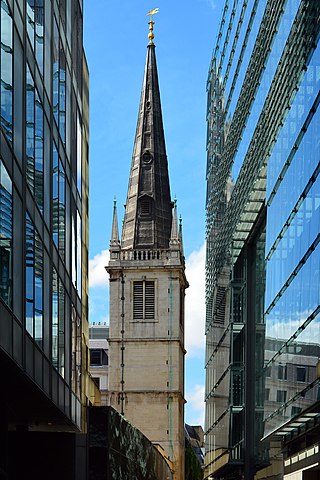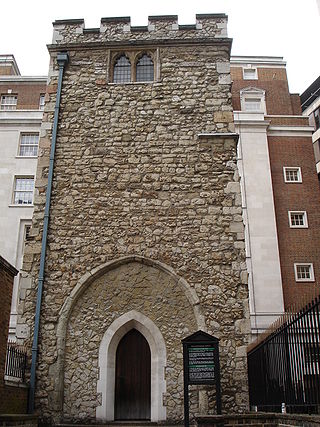
The Church of St Benet Paul's Wharf is a Welsh Anglican church in the City of London, England. Since 1556, it has also been the official church of the College of Arms in which many officers of arms have been buried. In 1666 it was destroyed in the Great Fire of London, after which it was rebuilt and merged with nearby St Peter's. The current church was designed by Sir Christopher Wren. It is one of only four churches in the City of London to escape damage during World War II.

St Andrew-by-the-Wardrobe is a Church of England church located on Queen Victoria Street, London in the City of London, near Blackfriars station.

St Olave's Church, Hart Street, is a Church of England church in the City of London, located on the corner of Hart Street and Seething Lane near Fenchurch Street railway station.

St Margaret Pattens is a Church of England church in the City of London, located on Eastcheap near the Monument. The dedication is to Saint Margaret of Antioch.

All Hallows Staining was a Church of England church located at the junction of Mark Lane and Dunster Court in the north-eastern corner of Langbourn ward in the City of London, England, close to Fenchurch Street railway station. All that remains of the church is the tower, built around AD 1320 as part of the second church on the site. Use of the grounds around the church is the subject of the Allhallows Staining Church Act 2010.
St Margaret Lothbury is a Church of England parish church on Lothbury in the City of London; it spans the boundary between Coleman Street Ward and Broad Street Ward. Recorded since the 12th century, the church was destroyed in the Great Fire of London in 1666 and rebuilt by the office of Sir Christopher Wren. St Margaret Lothbury still serves as a parish church, as well as being the official church of five Livery Companies, two Ward Clubs and two Professional Institutes. It also has connections with many local finance houses, all of which hold special services each year.

St. Mary Somerset was a church in the City of London first recorded in the twelfth century. Destroyed in the Great Fire of 1666, it was one of the 51 churches rebuilt by the office of Sir Christopher Wren. The tower is located in Upper Thames Street, the body of the church being demolished in 1871.

St Lawrence Jewry next Guildhall is a Church of England guild church in the City of London on Gresham Street, next to the Guildhall. It was destroyed in the Great Fire of London in 1666, and rebuilt to the designs of Sir Christopher Wren. It is the official church of the Lord Mayor of London.

All-Hallows-the-Great was a church in the City of London, located on what is now Upper Thames Street, first mentioned in 1235. Destroyed in the Great Fire of London of 1666, the church was rebuilt by the office of Sir Christopher Wren. All-Hallows-the-Great was demolished in 1894 when many bodies were disinterred from the churchyard and reburied at Brookwood Cemetery.

St. Stephen's Church, Coleman Street, also called "St Stephen's in the Jewry", was a church in the City of London, at the corner of Coleman Street and what is now Gresham Street, first mentioned in the 12th century. In the middle ages it is variously described as a parish church, and as a chapel of ease to the church of St Olave Old Jewry; its parochial status was defined permanently in 1456.

St. Bartholomew-by-the-Exchange was a church and parish in the City of London located on Bartholomew Lane, off Threadneedle Street. Recorded since the 13th century, the church was destroyed in the Great Fire of London in 1666, then rebuilt by Sir Christopher Wren. The rebuilt church was demolished in 1840.

St George Botolph Lane was a church off Eastcheap, in the ward of Billingsgate in the City of London. The rear of the church overlooked Pudding Lane, where the fire of London started. It was first recorded in the twelfth century, and destroyed in the Great Fire of 1666. It was one of the 51 churches rebuilt by the office of Sir Christopher Wren. The church was demolished in 1904.

Gresham Street in the City of London is named after the English merchant and financier Thomas Gresham.

St Benet Gracechurch, so called because a haymarket existed nearby (Cobb), was a parish church in the City of London. First recorded in the 11th century, it was destroyed in the Great Fire of London of 1666 and rebuilt by the office of Sir Christopher Wren. The church was demolished in 1868.

St Mildred, Poultry, was a parish church in the Cheap ward of the City of London dedicated to Anglo-Saxon Saint Mildred. It was rebuilt after the Great Fire of London, and demolished in 1872. St Mildred in the Poultry was the burial place of the writer Thomas Tusser. Some description of the church and its monuments is given in John Stow's Survey of London.

St Christopher le Stocks was a parish church on the north side of Threadneedle Street in the Broad Street Ward of the City of London. Of Medieval origin, it was rebuilt following the Great Fire of London in 1666, but demolished in 1781 to make way for an extension of the neighbouring Bank of England.

St Mary Colechurch was a parish church in the City of London destroyed in the Great Fire of London in 1666 and not rebuilt.

Seething Lane is a street in the City of London. It connects All Hallows-by-the-Tower, Byward Street, with St Olave's Church, Hart Street. The street is named after an Old English expression meaning "full of chaff", which was derived from the nearby corn market in Fenchurch Street. Samuel Pepys lived there and is buried in St Olave's Church at the junction with Hart Street. A bust of Pepys, created by Karin Jonzen, sits in the public garden at the south end of the street.

Hart Street is a small street in the City of London.


















